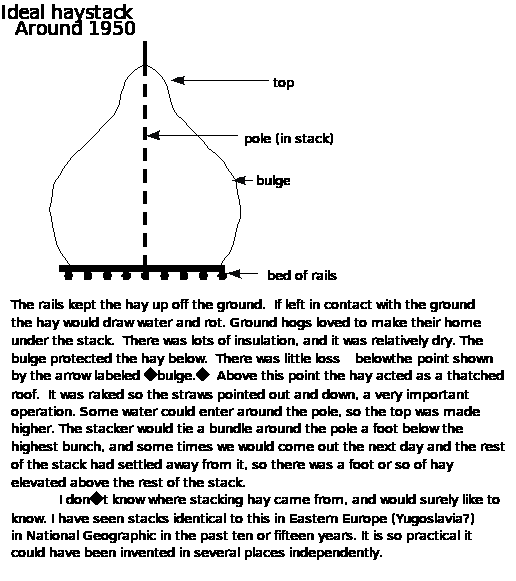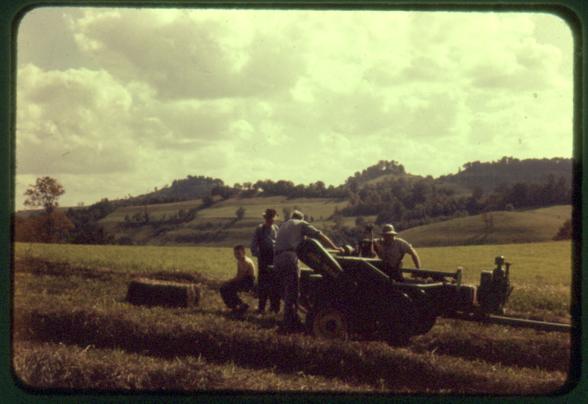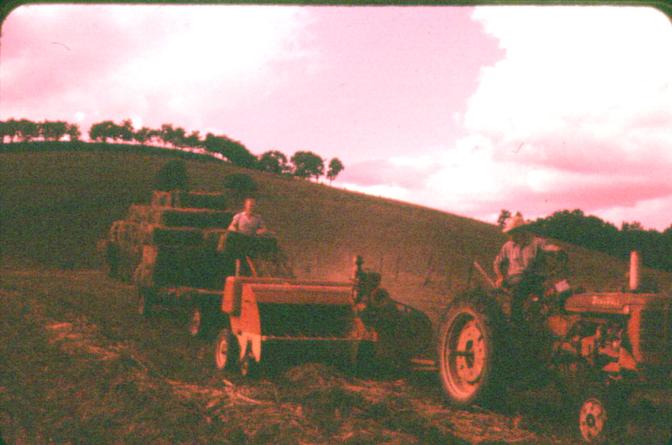Granddad always raked the stack, so that straws attached to the outside of the stack pointed down and out to carry rain water away from the center, like thatch. A well made stack had very little hay lost to rotting. Sometimes they would last for several seasons before they were fed. My first job making hay stacks was hauling shocks. Papaw Kennedy had a pole that had been cleared of bark, and flattened on one end and pointed on the other. A clevis was attached to the flattened end. This is a U shaped piece of metal with holes in the ends to admit a bolt. The bolt went through one side of the clevis, through a hole in the flat end of the pole and then through the other side of the clevis. A rope went through the clevis. It had a ring in the end of it, too large to go through the clevis, and large enough to go over the pole at its largest diameter. The other end of the rope was attached to the single tree of the horse's harness. I would ride the horse out to a man at a shock. He would slide the pole
(Illustration 9-1)

Hay Stack
under the shock, throw the rope over the shock, and slip the ring over the sharpened end of the pole. When the horse began to move toward the stack, the rope pulled down over the shock, securing it. When we got to the stack, I would back up the horse, the man who was "pitching" (putting the hay up on the stack) would pull the slack rope back through the clevis, and pull the ring off the pole. I would start back to the man who was "hooking up" the shocks, and the pole would follow, leaving the shock at the stack.
We used a four prong fork to make the part of the stack up to eleven or twelve feet. After that we switched to a three prong fork with a long handle to go up to sixteen or seventeen feet. Not much hay went above this level, because it was so much work to get it there, but there was a "topping out fork" to put the little knot on the top which helped prevent rain from running down the pole. When we made hay at the Stout place (now owned by John Stenger), with T. J. Mick, there was a special two prong fork with a "sucker rod" for a handle. These sucker rods were used at one time to reach from the walking beam of an oil well down the hole to the pump at the bottom the well. One could put a small bunch of hay over twenty two feet high with that fork.
This was about the time of World War II. Everybody used this system. After the war, Dad got a buck rake, which I have described. Granddad Kennedy used his dump rake to rake hay for it. The new device was much faster. By this time Uncle Gene, who was to take over the farm, and I did the pitching, Granddad stacked, and Dad brought in the hay. Gene would mow in the morning, with the grass to be put up two days later. Granddad would start raking for that day's stacks about ten or ten-thirty. The stacking would begin after dinner (the noon meal) and we would make three stacks a day. On Friday we would often do five. Being Seventh Day Baptists, we would rest and go to church on the next day. This schedule was punctuated by the weather, but many weeks we made twelve or fourteen stacks.
The work was excellent exercise. I have kidded with the athletic boys in my classes at school that, although weight lifting was unheard of in my high school football days, my father had a "weight training program" for me anyway. One way that pitching hay is different from weight lifting is that in pitching hay the weight is off to one side, and never balanced across the axis of the body until it is near the maximum height it reaches. Also the motion of the muscles is more complex. If you always lifted from the right side, your development would become very unbalanced. But since the work is continuous, you rest by lifting from the left side part of the time. When the longer fork is used, you pick up the load as usual, then put the end of the handle into a pocket on the ground to raise it up over head, and elevate the fork hand over hand to get to the level you want to place the hay. We took no "breaks" but to drink and "relieve" ourselves.
When it would rain Granddad Kennedy would come down from the stack, we would all get on the side away from the storm, each would take up a bunch of hay on his fork and prop it up over head to stay dry. If it was a very short shower we would go back to work afterward. More often we would have to wait, sometimes until the next day or later.
One infamous day I ran a prong of the pitchfork through the fleshy part of Uncle Gene's thumb, between the thumb and forefinger. He said a few choice words, but admitted he had not been careful which contributed to the accident. He didn't go to the doctor and it healed up properly. It must have been pretty sore to finish up the stack and to milk. They had a dairy long after Dad did and had to milk twice a day. They may have had a milking machine by that time, though. They used one in later years.
The big change came when Dad bought a bailer. The bailer was invented to decrease labor in an era when agricultural labor was becoming scarce. It was possible to harvest hay faster, but it was no less hot and arduous. To begin with the bales were put on the ground, and picked up by hand. Then they were put on an elevator which put them in the barn, where they had to be pulled back and placed. On the Kennedy farm some went into sheds on the hill for stock cows and some went into the dairy barn not far from the house for milk cows.
We had thirty acres of level land at the Lost Creek farm, and when I got to the point where I had some influence, I talked Dad into putting a chute on the back of the bailer which ran the bales up onto the wagon. That saved a lot of labor, substituting the skill of walking back and forth on the moving wagon for lifting bales off the ground.
(Illustration 9-2)

Making hay in 1956. From the left: young Gene Kennedy, Grandfather, Steven G. Kennedy, my father Paul V. Bond, and my uncle, Gene Kennedy. From a slide taken while home on leave from the Army. The bailer belonged to Gene. Lewis Swisher's hill in the background.
We continued to make bales that way even after we got the Jesse Run farm in 1962. There we put the bales in the barn across the road from the house. It took three rounds of cutting and bailing to put up the meadow below the little run that comes down from the vicinity of the locust grove beside the house. When brother-in-law Ward Maxson bought the Smith place in May 1977, we got Ray Smith's machinery, including a round bailer. And that changed the way we made hay. It was a Model C Vermeer, hard to get the bales started, soft bales, but it covered a lot of ground. At this writing in the year 2000, we still use a Vermeer, a Model I, and let them sit out in the weather until they are used. They are "parked" in a bale lot until winter. I had a Model G Vermeer round bailer for 17 years before buying this one last year.
(Illustration 9-3)

One of the advantages we had on the home farm was relatively level ground. We had thirty of the 150 or so acres of relatively level ground at the confluence of the Stonepot Run and Lost Creek. This is Dad and I working on Bob Lowther's farm, adjacent to ours. Putting the bales up to the wagon, rather than picking them off the ground, saved a lot of labor.
Aside: When I was a kid I went with Dad to make hay on the Stout place on Stonepot. Dad drove the tractor with the buck rake, and I pitched hay onto the stack. One of the skills I learned at the upper Stout place, on Little Stonepot, now owned by Bob Mendez' heirs, was how to drink from a spring. We carried jugs with ice water, but it sometimes ran out on a hot day.
This is how it is done. First you look around and make sure there are no snakes or small animals present. Then you get down on your hand and knees and blow on the water to push aside the thin, almost invisible scum that is always present. Then you extend your lips to make a short tube into the water and draw the water up through it.
We didn't do this much, but the procedure is surely so old it certainly came along with my first ancestors who came to Western Virginia in 1799. Likely it is much older than that. Now camping stores sell water purification devices for such occasions, and no one would think of using water from the outdoors without purifying it.
| Next Chapter | Previous Chapter | |
| Chapter 10: Nostalgia: 1. Making Silage | Contents | Chapter 8: Earliest Memories:4. At First I Hated Farming |
Copyright © 1998, 2006, 2008, 2011 S. Tom Bond (stombond at hughes.net)